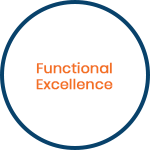Operational Excellence
For us at RvaluE, based on our ‘hands on operations’ and practitioners’ experience of over 25 years in this field, we have a strong conviction that Operations is the foundation of Business Services and Operational Excellence as a mindset, is ‘core’right from Set-up till Transformation.
Operations has been the starting point for our entry into Business Services arena. Literally, in mid-90s, we had to learn and write the ‘rule book’ for the various stages of offshoring: right from blueprinting and business case preparation to transition to operations, and to finally, transformation and connecting with core business. The Three Rings of Service Excellence – Brilliant at Basics, Functional Excellence and Value Added Services - was



We brought this focus and pedigree to RvaluE from the time of formation and the Team has practised operations as a discipline to success and to achieve the mission of ‘realizing business value’. We preferred end-to-end engagements from setting up of Shared Services right up to stabilization, and we have kept this ‘operations’ perspective and our proprietary frameworks consider this as an integral element to designing for excellence. With almost every client, we have been involved from 5 to 7 years of their shared services journey and have been part of not only ensuring excellence in operations and implementing transformational engagements, but also spot the challenges they faced and the kind of support they require to make them reap the benefits of BPM.
In fact, we can firmly say that, well-run Business Services operations is a pre-requisite to drive transformation, particularlywithin Captive Shared Services units and the linkages to help grow the Customer’s or Company’s core business. With a view to achieving Operational Excellence and the resultant Transformation, we have implemented various ‘engagement models’ with our clients and customers in India and overseas in multiple different ways to deliver on their desired goals, requirements and expectations.
The above operations experience, operational excellence focus and a variety of engagement models were directly instrumental for RvaluE Group Leadership Team to spot the customer demand and innovate for a new operating model, particularly for small to mid-size Captive Operations, irrespective of the size of the Organization in terms of revenues or number of overall employees! This led to creating the venture of Dedicated Captive by the RvaluE Group.
In simple terms, there are Two Components to achieve Operational Excellence:
Brilliant At Basics
Maturity of three drivers of Business Services.
Brilliant At Basics (BAB)
Initially, Brilliant at Basics started with sports and arts, and progressively have been applied to business and professional expertise. Our operations experience demonstrates that the basics are the fundamentals that enable a Business Services organization of any size to operate effectively as a single value creating unit. Few identified 'fundamentals' are not just basics, but are most important for operations and that lead to success. Interestingly, these are also fundamentals, despite being basics, that we, quite often, are not dedicated to make them as 'habits' and have not focused to deliver ‘consistent best performance’.
When we invest on these fundamentals or basics in a ‘brilliant’ way i.e. ‘with dedication’ and 'consistency for being the best', we will be able to achieve operational excellence’. We have identified and practised ‘seven’ areas in Operations that require being Brilliant at Basics (BAB) and referred to as 7 ‘C’s:

Maturity of Drivers
There are three drivers to all Business Services operations: People, Process & Technology. In order to achieve Operational Excellence, these three drivers have to reach the desired levels of ‘maturity’ across the lifecycle of Business Services journey.
People
Process
Technology
First, the focus starts right from visualizing or creating a 5 year business case while consolidating or carving out of corporate functional processes, and aligning goals to business goals.
Second, designing for excellence at the time of transition like proper org design, training and knowledge transfer for people, appropriate design or redesign of processes, with proper hand offs, unbundling, documentation and consolidation and best-in-context technology, with proper plans for optimization of existing ERPs and deployment of new tools.
Third, as we progress with go live and operations, there are:-
- People Maturity Models ensuring right structure, span, skill, mix, training, teamwork, engagement, performance, development, and growth,
- Process Maturity Models enabling right stabilization dashboards, metrics, proper input controls, adherence to process manuals, segregation of duties, dealing with exceptions and CAPA (Corrective Action – Preventive Action), collaborative mindsets to perform processes collectively, CAT in service and outputs to customers, and
- Technology Maturity Models supporting tech infra, telecom networks, ERP implementation, alignment of interfaces, deployment of BPM and new age tools, high %age of automated controls, data security, privacy and protection and tech based analytics.
Finally, in Transformation and connecting with business, flexibility to take care of peaks and troughs, focus on customer experience while delivering on improvements and savings, upstream - downstream linkages of processes and systems, fixing front end issues and enhancing front end business controls, value adding and creating solutions focus and becoming an extension of the business and the client’s organization.

